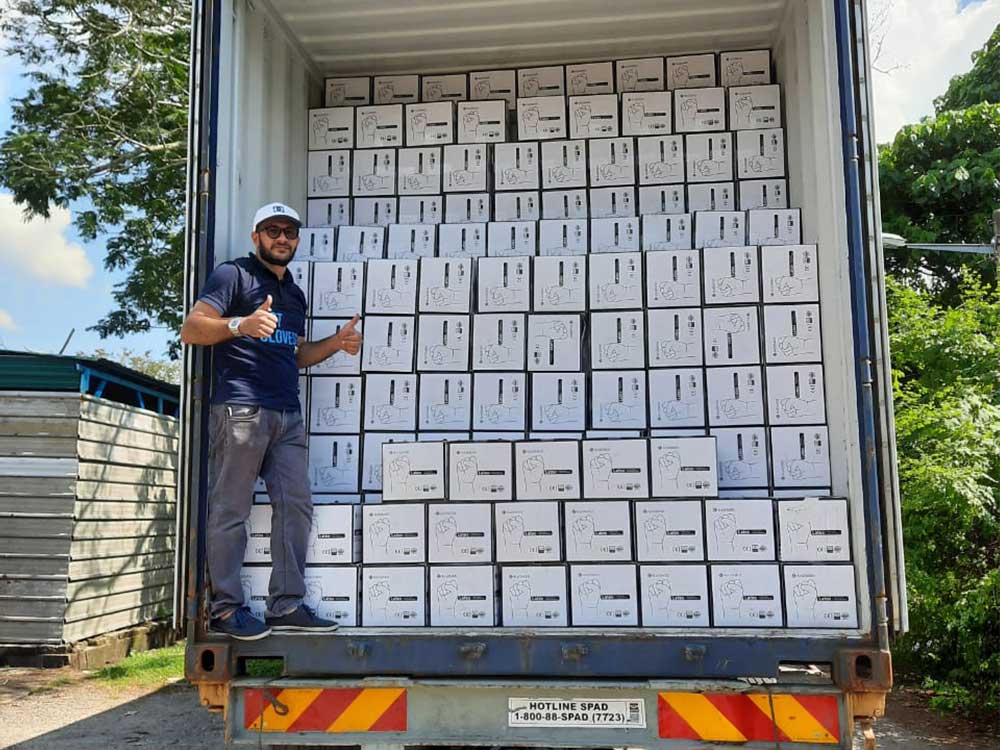From cooking, cleaning, and washing the dishes to handling chemicals, machinery, and tattooing. Gloves are a standard and a must in many different fields in our daily lives.
If you look around you wherever you go and pay close attention to people around you, you will find people using gloves almost everywhere.
Of course, now that gloves are integrated into many different fields and also simple chores just as well, we need to know a lot about what is the glove of choice for every situation, how to use them, how to dispose of them properly, and the proper way to handle them.
One of the most important aspects is how often you need to change your gloves.
Of course, there are obvious reasons why you would need to change your gloves which are breaking and puncturing, or if the gloves get dirty.
But is that all? What if that never happens? When is the best time to change your single-use gloves? Does it differ from one type of glove to another? Is it the same for different jobs and different uses?
In this article, we will be answering this question and much more.
But first of all, let’s answer some simple, frequently asked online questions.
Can you reuse disposable gloves after washing them with soap and water?
Due to the glove shortage that happened at the beginning of the Coronavirus epidemic, some people were wondering whether it’s okay to reuse disposable gloves.
Some asked if they could simply wash them with soap and water. Some people were even wondering if they could just disinfect these gloves with alcohol.
And the answer to that is simple, No.
Disposable, single-use gloves and especially the ones food workers use in the food industry, and the doctors, nurses, and caregivers use in the healthcare profession, are gloves that the manufacturing companies developed mainly to be used as single-use and to be disposed of when the user takes them off.
What are the ultimate reasons you should change your gloves immediately?
You should change your gloves immediately if they get torn or if you see any holes in them; if that happens then the glove’s protective barrier is immediately compromised.
And also if they get dirty. If you do not change dirty gloves, you would be transmitted whatever you have on these gloves to your surroundings.
If you touch your hair, or your face, if you search for an itch, or touch any part of your body. You have to remember that anything you touch while wearing your gloves could contaminate them.
And vice versa, work gloves collect different types of microorganisms on their surface, so if you touch your body with used gloves, you would simply be transferring whatever happens to be on these gloves to your body. Another form of cross-contamination.
This is exactly when you must change single-use Gloves.
Of course, these are general rules that most people know about now:
What happens if you wear gloves for too long?
Gloves can protect you from many harmful substances, but if you wear the unnecessarily for too long, your skin can become wrinkly and dry.
Also, wearing gloves for extended periods can cause moisture build-up, which may cause fungal infections.
On the other hand, if you keep using the same gloves for way too long, you would be stretching the material a lot as you keep moving your hands, and that might compromise the glove’s protective barrier in some cases, like vinyl gloves for example.
That is why you should follow the protocol on when you should change single-use Gloves.
For how long can I safely wear Latex gloves at work?
Latex gloves are disposable; you should never reuse them under any circumstances.
Generally speaking, after wearing Latex gloves for about four hours, you should change them, wash your hands thoroughly and then wear new ones.
Latex gloves are relatively inexpensive; they are made from natural rubber, and they are flexible and very protective against microorganisms.
That’s why people safely use them in the food industries and the medical field, and nowadays, some people even use them in their daily lives to protect themselves again Coronavirus infection.
The only downside to Latex gloves is that some people are allergic to them. These people might prefer using nitrile gloves or vinyl gloves, for example.
Need to know more about the difference between vinyl and Latex gloves? We give you all the answers and more here.
How long can you still wear the same gloves?
Latex gloves are safe to use for a relatively extended period of time.
However, Latex gloves are relatively thin; even if they do not cause irritation to your skin or allergy, you should still change them regularly to avoid compromising the gloves’ protective barrier.
A simple rule is you must change your single-use gloves every time you start a new task to avoid cross-contamination; That can be specifically for food workers and caregivers, but also generally.
For example, some cleaning tasks require the use of chemicals that might be harmful to your skin.
In that case, you should change your cleaning gloves to avoid transferring these hash chemicals to other surfaces you might touch with your bare hands later.
Do you need gloves that can protect you from harmful chemicals? Here is your guide for chemical-resistant gloves.
And, of course, you should change your single-use Latex gloves if they tear or break immediately.
Moreover, you should dispose of your Latex gloves properly to avoid contaminating other surfaces with microorganisms that accumulate on your gloves while you use them.
And, of course, never touch your face or hear with your used gloves. As this will transfer whatever microorganisms are on your gloves to your body.
We will be answering more frequently asked questions as we go on. But now let’s discuss this in more detail:
When must you change single-use Gloves in different industries?
To answer this question correctly, we must break it down into more specific, detailed questions. When must you change single-use gloves for each different specific use?
For example:
When must you change single-use Gloves in the food industry?
The main reason why food workers should not touch ready-to-eat food with their hands is to prevent the transmission of viruses and bacteria from hands to food.
Although invisible to the naked eye, microorganisms are present in your hands and can easily be transmitted to the food.
Here comes the importance of the use of gloves. It helps create a sanitary environment in food handling.
However, before wearing gloves, food workers should wash their hands thoroughly.
When are food workers required to wash their hands?
First of all, of course, before they start working, food workers should wash their hands. Also, right before wearing single-use gloves.
They should also wash their hands before touching raw or frozen beef, poultry, or fish.
Moreover, they must wash their hands after eating, drinking, or touching anything or any surface with their bare hands.
And, of course, after using the bathroom, mopping, sweeping, and removing the garbage.
Following an excellent hand-washing technique is a must; All employees involved with food preparation must wash their hands and exposed areas of their arms with soap and water for at least 20 seconds.
Then, a thorough rinse with clean water then dries with a single-use towel or s dryer.
What types of gloves do food workers usually use?
Gloves used in food service are usually polyethylene gloves, Latex gloves, nitrile, or vinyl gloves.
Here is your guide on the best gloves for cooking
And the best grilling gloves options.
What are food-grade gloves?
Food-grade gloves are disposable gloves that the FDA approves for use with food, food packaging, and food assembly.
The key here is whether these gloves are considered safe for use with food.
Moreover, you can wear food-grade gloves over cut-resistant gloves. Providing a double protective layer.
What worst can happen if food workers do not wear gloves when needed?
There is a wide range of foodborne illnesses that the food handlers’ hands can transmit into the customer’s food, such as Salmonella, traveler’s diarrhea, Hepatitis A, Listeria, typhoid, and Haemorrhagic colitis.
Good hand-washing techniques, wearing gloves, and changing them when needed are the main ways the food industries protect their customers from potential infections.
When should food workers change single-use gloves?
You should change single-use gloves whenever you are handling a new ingredient.
For example, change gloves after handling raw fish or raw meat. For example, you can not use the same gloves when preparing a salad. The microorganisms in the raw meat should never be transmitted to ready-to-eat food like salad.
Also, you must change single-use gloves before preparing a dish for a customer with specific food allergies to avoid contaminating their food with the food they are allergic to.
On the other hand, while you should wear cleaning gloves while cleaning to prevent chemicals and bacteria from coming in contact with your skin, you should change these gloves and wear new gloves when you start preparing food.
Also, if you touch your face, hair, or an unclean surface, you must change your single-use gloves because there is an unlimited number of microorganisms in the human body. It might not be harmless on the skin, but it is harmful to consume.
And, of course, if your gloves break or become contaminated, you should change them immediately.
But if none of these things happen, the rule is to take off your disposable gloves, wash your hands, and put on new gloves after 4 hours of continuous use.
This is the FDA recommendation because, after 4 hours, pathogens could start spreading a contaminating the food you are working with. So it is a must to keep track of time once you put your gloves on and start working.
Now that we explained when to remove single-use gloves, here are some frequently asked questions regarding food industry workplace hygiene:
What are the risks of not changing gloves when you are a food worker?
There are many dangers associated with noting single-use gloves while working with food. Mainly these problems are cross-contamination and hygiene issues.
For example, handling raw vegetables right after raw meat using the same gloves.
Even if you wash these gloves with soap, researchers found that this is not enough to eliminate the bacteria from handling raw meat because high temperatures are the only way to kill these bacteria, hence cooking the meat.
Are reusable gloves safe for food handling?
From what we mentioned earlier, it is evident that reusable gloves are not what researchers recommend for food handling. It is necessary to avoid cross-contamination at any rate. And nothing can guarantee that, like disposable gloves.
What kinds of food should the food worker not touch with bare hands?
The list contains mainly food that would not touch the fire in the process between the food worker touching the food and the customer eating it, which are mainly: sandwiches and cold cuts, salads, fresh fruits, bread and baked goods, ice, garnishes, and fruits for fresh drinks.
These are the essential info regarding safe food handling guidelines(1). Now that we got that covered, what about other fields and industries?
When must you change single-use Gloves in the medical field?
Working on open wounds is a very critical and sensitive issue. It is the easiest way a person can get infected.
Not only the patient but also the caregiver working on the wound. If the caregiver has any wound, the infection can travel both ways between the patient and the caregiver.
That’s why medical-grade gloves are so crucial in the aseptic protocol in the medical field.
What made medical gloves so important?
Before scientists developed Latex gloves, it was easy to contract infections; even with good hand-washing techniques, it wasn’t enough to protect patients and caregivers from infection.
Now thanks to medical-grade gloves patients and doctors can interact safely without the danger of cross-contamination and infection.
Medical-grade gloves offer the highest levels of protection against microorganisms and the ability to make fine hand movements, which is equally important to doctors.
Of course, in the medical field, caregivers use exclusively single-use gloves.
We will discuss when to dispose of them as we go on.
How should medical one use gloves be used?
First of all, use a new pair of gloves for each patient. Never re-use the same pair of gloves on multiple patients.
Also, if you have any cuts or wounds on your hands, you should cover them with occlusive dressing before you wear gloves.
You should also wash your hands before and after wearing and taking off the gloves and between examining the patients. This step is as crucial as wearing gloves.
And also, beware that you must use gloves when you provide any care for any patient that requires skin-to-skin contact.
Also, you should use gloves during all patient activities that might involve exposing you to the patient’s blood and any body fluids and exposure to the patient’s mucous membrane and open wounds.
Moreover, you should examine your gloves regularly while you use them to make sure they don’t become damaged while you use them.
When must you change one use gloves as a caregiver?
You must remove your gloves right after handling a patient and follow hygiene protocol and hand washing techniques. As gloves act like a vehicle for the transmission of microorganisms.
Also, if your gloves become damaged, you should remove the immediately. Then perform proper hand hygiene protocol before wearing a new pair of gloves.
Of course, you should also remove one-use gloves when they come in contact with blood or another body fluid.
And another thing people might not know is that you must change one-use gloves when you move from touching a contaminated body site of a patient to another site on that same patient.
Moreover, you must change your use of medical gloves at regular intervals to protect both the patient and the caregiver.
Because while the gloves protect you from microorganisms, these microorganisms gather on the glove itself as you use them.
And, of course, the same pair of single-use medical gloves must never be used for the care of more than one patient.
We must mention something as we discuss medical-grade gloves; you need to be aware of your patient’s allergies. For example, some patients may suffer from Latex allergy.
When working with these patients, it is imperative to avoid wearing Latex gloves to avoid causing an allergic reaction.
Do you suffer from Latex glove allergy? Here is your guide to 6 popular non Latex gloves.
Now that we discussed when you must remove single-use gloves in different professions and fields let’s discuss general tips for the user on the disposal of single-use gloves.
General tips and tricks on when you must change single-use gloves
First, you must remember that simply wearing gloves is not enough.
Whether in the food industry, medical field, or simple day-to-day use in the age of the Coronavirus pandemic, it is not enough to just wear your single-use disposable gloves.
Always wash your hands with water and soap for at least 20 seconds, dry your hands properly, and then wear your gloves.
Gloves alone, without good hand-washing techniques, are not enough to prevent cross-contamination and the spread of diseases.
Also, washing your hands after you take off your single-use gloves is a must to ensure that there are no bacteria or other microorganisms on your hands afterward.
Moreover, you should always check your gloves for rips, tears, and cracks before you wear them, while you are wearing them, and after taking them off.
You should remove your gloves immediately if you find any tear or crack on them. It is essential to keep an eye out for that, especially when dealing with sharp objects.
Some people may not know this, but it is equally crucial to find gloves that fit your hands perfectly. Gloves that are too tight might tear easily, while gloves that are not tight enough may not provide proper protection against microorganisms.
You should never wash or sanitize single-use gloves to wear them again.
Moreover, gloves are not for sharing; you should never share your used gloves with anyone else.
Single-use gloves are designed for single use; you should never wear them again after taking them off or giving them to anyone else.
Looking for echo-friendly gloves? Here is your guide to gloves that help you save the environment.
Conclusion
Knowing when to change your single-use gloves is as important as wearing them. Because once they are no longer helpful, they might begin to harm you.
Also, you must remember that the manufacturing company designed single-use gloves for you to dispose of them after using them one single use.
Of course, there are obvious times when you will notice that you need to change your gloves, but other than this, we hope we were able to shed some light here on the times when you may not know that you need to dispose of your gloves. We hope we were able to help you with that.
And as always, stay safe, and let us know in the comments if you have any questions we can help you with.







